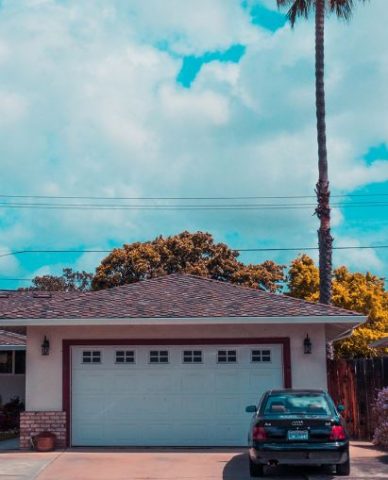Garage Door Care is very important
You pull into and out of your garage hundreds of time a year, ever expecting your door to reliably open and close at your whim. Going up and down so much can be pretty taxing, which is why after being neglected for months or years, garage doors rightfully start to complain loudly.
If your door sounds more like a train’s “clack-clack” as it runs down the track, you’ve definitely let things go way too far. Fortunately, garage doors tend to be pretty foolproof and tolerate neglect more than other important parts in your home. But you’re not going to be neglectful, you’re going to do regular inspections and maintenance so it’ll last even longer, right?

image by HomeKeepr
Parts of a Garage Door
This may come as some surprise, but a garage door is more than a door. It’s a system of moving parts that we conveniently label as a “door.” Modern garage door systems include important pieces like:
* Opener. You know this one, it’s that big box in the center of the garage ceiling. The opener is designed with a shuttle that moved the door up and down with the help of a chain, screw or belt-driven motor. You can even get Smart Garage door openers now.
* Springs and cables. Your door might feel light if you manually lift it while it’s hung, but this is because of a highly tensioned giant spring (or two) mounted above your door and the cables that are attached. Always treat these with the respect required, they can be very dangerous to work on directly (call a pro!).
* Sensors. If you look closely near the bottom of each garage door track, you’ll see sensors that resemble tiny cameras. As a team they maintain an almost invisible laser beam that causes the door to reverse if something suddenly breaks it during door decent.
Of course, there are other bits and pieces we could talk about, but this is about taking care of your door, not examining its anatomy. We’ll do that another time. Just understand that these three systems are vital to the door’s function and without all of them in working order, the door becomes very unsafe and unreliable
Taking Care of Your Home’s Biggest Front Door
If you can’t remember the last time you did anything with your garage door, now is the time to get on this. The weather’s perfect and you could stand to get outside anyway. There are a few tasks that you should absolutely not attempt without help or considerable experience, like replacing a broken spring, but for the most part, garage door maintenance is a snap.
Run down this checklist and your door will be ready to roll again!
* Tighten all screws and bolts. That rattling sound isn’t just for ambience, your garage door vibrates as it moves up and down, slowly backing screws and bolts out. Start at the bottom and work your way up, tightening all fasteners and replacing any that seem to be missing or broken. Don’t forget to check the hinges between door panels!
* Pull the manual garage door release. With the garage door closed, pull that handle hanging down from your opener. With the opener’s shuttle unlocked, check your door’s balance by opening the door about half way. If it stays where you put it, you’re gold. If not, call a pro to help — rebalancing a door can be difficult and dangerous. Don’t forget to push the door open all the way to re-engage the opener’s shuttle.
* Check the safety reversal system. Grab a scrap 2×4, cement block or something of similar size and shape and place it directly in the path of the garage door. Make sure that the object isn’t breaking the beam, since this is testing a different part of your system. Now, shut the door using the garage door opener.
If the door stops as soon as contact is made, your safety reversal system is set properly. If not, you’ll need to find your manual and look up which knob or button is used to decrease the force required to stop the door. This is one of those things you’ll test way more often than you’ll have to adjust.
* Break the beam. Check that the indicator lights on your infrared sensors are showing that the eyes are adjusted properly. Once they’re looking deeply into each other’s eye, close the garage door. Before it reaches the ground, pass a broom between the sensors. The door should stop, otherwise your sensors may need to be cleaned or replaced.
* Grease some squeaky wheels. You’ve tightened hardware, tested the door’s safety features and you’re ready to go nap in your hammock. But wait! There’s one more thing. It’s time to lube the beast. You won’t actually be lubricating a lot of the system, you’ll be cleaning it, but it’ll run more smoothly and that’s the point.
Start with the track itself, cleaning it with carburetor or brake cleaner and a cloth. Next, using a silicone based garage door lubricant, spray between the pin and wheel on each roller, wiping off any excess (lubricant doesn’t belong on the track). If your rollers are nylon, take extra special care because they slip easily.
You can also use the same lubricant to coat the outside of your torsion spring (the one above the door itself). Again watch for drips.
Are You Feeling a Bit More TGIF Than DIY?
Not everyone wants to take their garage door into their own hands. Even people who do sometimes hit problems that they simply don’t have the expertise to handle. That’s ok, that’s why the HomeKeepr community is such a thriving resource — everyone you could ever need to call is participating! Just log in and check out the overhead door experts that your Realtor has already recommended. They can come out and give your door a quick one-over, then set up inexpensive regular maintenance, saving you thousands of dollars in major repairs. Taken from HomeKeepr.com
When you are ready to buy or sell a house, contact Dupont Real Estate. We are here for you.

